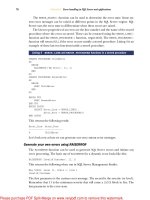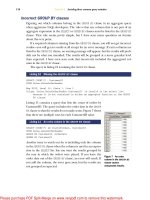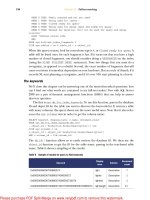SQL server MVP Deep dives Volume 1
Bạn đang xem bản rút gọn của tài liệu. Xem và tải ngay bản đầy đủ của tài liệu tại đây (12.67 MB, 852 trang )
MANNING
DEEP DIVES
EDITED BY
Paul Nielsen Kalen Delaney Greg Low Adam Machanic Paul S. Randal Kimberly L. Tripp
MVP CONTRIBUTORS
John Baird Bob Beauchemin Itzik Ben-Gan Glenn Berry Aaron Bertrand Phil Brammer Robert C. Cain Michael Coles John Paul Cook Hilary Cotter
Louis Davidson Christopher Fairbairn Rob Farley Denis Gobo Bill Graziano Dan Guzman Paul Ibison Tibor Karaszi Kathi Kellenberger Don Kiely
Kevin Kline Hugo Kornelis Alex Kuznetsov Matija Lah Cristian Lefter Andy Leonard Greg Linwood Bruce Loehle-Conger Brad McGehee Paul Nielsen
Pawel Potasinski Matthew Roche Dejan Sarka Edwin Sarmiento Gail Shaw Linchi Shea Richard Siddaway Jasper Smith Erland Sommarskog
Scott Stauffer Tom van Stiphout Gert-Jan Strik Ron Talmage William R. Vaughn Joe Webb John Welch Erin Welker Allen White
●
●
●
●
●
●
●
●
●
●
●
●
●
●
●
●
●
●
●
Author royalties go to support War Child International
●
●
●
●
●
●
●
●
●
●
●
●
●
●
●
●
●
●
●
●
●
●
●
●
●
●
●
●
SQL Server MVP
Deep Dives
Licensed to Kerri Ross <>
Licensed to Kerri Ross <>
SQL Server MVP
Deep Dives
Edited by Paul Nielsen Kalen Delaney Greg Low
Adam Machanic Paul S. Randal Kimberly L. Tripp
MANNING
Greenwich
(74° w. long.)
Licensed to Kerri Ross <>
For online information and ordering of this and other Manning books, please visit
www.manning.com. The publisher offers discounts on this book when ordered in quantity.
For more information, please contact
Special Sales Department
Manning Publications Co.
Sound View Court 3B
Greenwich, CT 06830
Email:
©2010 by Manning Publications Co. All rights reserved.
No part of this publication may be reproduced, stored in a retrieval system, or transmitted, in
any form or by means electronic, mechanical, photocopying, or otherwise, without prior written
permission of the publisher.
Many of the designations used by manufacturers and sellers to distinguish their products are
claimed as trademarks. Where those designations appear in the book, and Manning
Publications was aware of a trademark claim, the designations have been printed in initial caps
or all caps.
Recognizing the importance of preserving what has been written, it is Manning’s policy to have
the books we publish printed on acid-free paper, and we exert our best efforts to that end.
Recognizing also our responsibility to conserve the resources of our planet, Manning books
are printed on paper that is at least 15 percent recycled and processed without the use of
elemental chlorine.
Manning Publications Co.
Sound View Court 3B
Greenwich, CT 06830
Development editor:
Lead copyeditor:
Typesetter:
Cover designer:
Jeff Bleiel
Andy Carroll
Dottie Marsico
Marija Tudor
ISBN 978-1-935182-04-7
Printed in the United States of America
1 2 3 4 5 6 7 8 9 10 – MAL – 14 13 12 11 10 09
Licensed to Kerri Ross <>
MVP contributors and their chapters
Cristian Lefter 21, 49
Andy Leonard 59
Greg Linwood 33
Bruce Loehle-Conger 52
Brad McGehee 24, 43
Paul Nielsen 1
Pawel Potasinski 19
Matthew Roche 57
Dejan Sarka 54
Edwin Sarmiento 35
Gail Shaw 42
Linchi Shea 48
Richard Siddaway 26
Jasper Smith 28
Erland Sommarskog 17
Scott Stauffer 38
Tom van Stiphout 14
Gert-Jan Strik 46
Ron Talmage 31
William R. Vaughn 18, 51
Joe Webb 30, 44
John Welch 56
Erin Welker 55
Allen White 27
John Baird 23
Bob Beauchemin 15
Itzik Ben-Gan 5
Glenn Berry 34, 47
Aaron Bertrand 29, 53
Phil Brammer 58
Robert C. Cain 13
Michael Coles 10, 11
John Paul Cook 39
Hilary Cotter 37
Louis Davidson 1, 2
Christopher Fairbairn 22
Rob Farley 7, 40
Denis Gobo 8, 20
Bill Graziano 6
Dan Guzman 32
Paul Ibison 36
Tibor Karaszi 25
Kathi Kellenberger 9
Don Kiely 16
Kevin Kline 45
Hugo Kornelis 3, 4
Alex Kuznetsov 41
Matija Lah 12
Technical Editor
Rod Colledge
v
Licensed to Kerri Ross <>
Licensed to Kerri Ross <>
To all children traumatized by the horrors of war
and War Child’s efforts to help children be children again
Licensed to Kerri Ross <>
Licensed to Kerri Ross <>
brief contents
PART 1
DATABASE
DESIGN AND ARCHITECTURE ..............1
Louis and Paul’s 10 key relational database design ideas 3
2 SQL Server tools for maintaining data integrity 11
3 Finding functional dependencies 28
1
PART 2
DATABASE DEVELOPMENT ..............................41
4
5
6
7
8
9
10
11
12
13
14
15
16
17
Set-based iteration, the third alternative
Gaps and islands
43
59
Error handling in SQL Server and applications
Pulling apart the FROM clause
73
86
What makes a bulk insert a minimally logged operation?
Avoiding three common query mistakes
111
Introduction to XQuery on SQL Server
119
SQL Server XML frequently asked questions
Using XML to transport relational data
133
150
Full-text searching 176
Simil: an algorithm to look for similar strings
200
LINQ to SQL and ADO.NET Entity Framework
Table-valued parameters
Build your own index
221
234
ix
Licensed to Kerri Ross <>
210
102
BRIEF CONTENTS
x
18
19
20
21
22
23
PART 3
Getting and staying connected—or not 255
Extending your productivity in SSMS and Query Analyzer 277
Why every SQL developer needs a tools database
Deprecation feature
283
291
Placing SQL Server in your pocket 297
Mobile data strategies
305
DATABASE ADMINISTRATION .........................319
24
25
26
27
28
29
30
31
32
33
34
35
36
37
38
39
PART 4
What does it mean to be a DBA? 321
Working with maintenance plans
PowerShell in SQL Server
41
42
43
44
45
46
344
Automating SQL Server Management using SMO
353
Practical auditing in SQL Server 2008 365
My favorite DMVs, and why
Reusing space in a table
381
403
Some practical issues in table partitioning 413
Partitioning for manageability (and maybe performance)
Efficient backups without indexes
421
432
Using database mirroring to become a superhero!
449
The poor man’s SQL Server log shipping 463
Understated changes in SQL Server 2005 replication
High-performance transactional replication
475
484
Successfully implementing Kerberos delegation
496
Running SQL Server on Hyper-V 518
PERFORMANCE TUNING
40
330
AND
OPTIMIZATION.....529
When is an unused index not an unused index? 531
Speeding up your queries with index covering 541
Tracing the deadlock 549
How to optimize tempdb performance 558
Does the order of columns in an index matter? 566
Correlating SQL Profiler with PerfMon
575
Using correlation to improve query performance
Licensed to Kerri Ross <>
583
BRI EF CON TENTS
xi
How to use Dynamic Management Views 590
48 Query performance and disk I/O counters 606
49 XEVENT: the next event infrastructure 619
47
PART 5
BUSINESS
INTELLIGENCE
...............................631
BI for the relational guy 633
51 Unlocking the secrets of SQL Server 2008 Reporting
50
Services
642
Reporting Services tips and tricks 660
53 SQL Server Audit, change tracking, and change
52
data capture
54
55
56
57
58
59
670
Introduction to SSAS 2008 data mining 687
To aggregate or not to aggregate—is there really a question? 700
Incorporating data profiling in the ETL process
Expressions in SQL Server Integration Services
SSIS performance tips
743
Incremental loads using T-SQL and SSIS 750
Licensed to Kerri Ross <>
709
726
Licensed to Kerri Ross <>
contents
preface xxxv
acknowledgments xxxviii
about War Child xxxix
about this book xli
about SQL Server MVPs xliii
PART 1 DATABASE
DESIGN AND ARCHITECTURE
............... 1
EDITED BY PAUL NIELSEN
1
Louis and Paul’s 10 key relational database design ideas
PAUL NIELSEN AND LOUIS DAVIDSON
1. Denormalization is for wimps 3
2. Keys are key 4
3. Generalize, man! 5
4. Class <> table 5
5. Data drives design 6
6. Sets good, cursors bad 6
7. Properly type data 7
8. Extensibility through encapsulation
9. Spaghetti is food, not code 7
10. NOLOCK = no consistency 8
Summary 9
7
xiii
Licensed to Kerri Ross <>
3
CON TEN TS
xiv
2
SQL Server tools for maintaining data integrity
11
LOUIS DAVIDSON
Protection tools
Data types 13
constraints 14
constraints 16
12
■
■
■
NULL specification 13 Uniqueness
Filtered unique indexes 15 Foreign key
Check constraints 17 Triggers 20
■
■
■
When and why to use what tool 24
Summary 26
3
Finding functional dependencies
28
HUGO KORNELIS
Interview method 28
Modeling the sales order 29
First step: finding single-attribute dependencies 31 Second step: finding
two-attribute dependencies 36 Further steps: three-and-more-attribute
dependencies 39 What if I have some independent attributes left? 39
■
■
■
Summary
40
PART 2 DATABASE DEVELOPMENT ................................41
EDITED BY ADAM MACHANIC
4
Set-based iteration, the third alternative
43
HUGO KORNELIS
The common methods and their shortcomings
Declarative (set-based) code
Set-based iteration
46
The most basic form
46
Summary
5
■
44
■
43
Iterative (cursor-based) code
Running totals
47
■
45
Bin packing 51
58
Gaps and islands
59
ITZIK BEN-GAN
Description of gaps and islands problems
Sample data and desired results 60
Solutions to gaps problem 61
59
Gaps—solution 1 using subqueries 62 Gaps—solution 2 using
subqueries 63 Gaps—solution 3 using ranking functions 64
Gaps—solution 4 using cursors 64 Performance summary for
gaps solutions 65
■
■
■
Licensed to Kerri Ross <>
CONTENTS
xv
Solutions to islands problem
66
Islands—solution 1 using subqueries and ranking calculations 66
Islands—solution 2 using group identifier based on subqueries 67
Islands—solution 3 using group identifier based on ranking
calculations 68 Islands—solution 4 using cursors 69
Variation on the islands problem 69 Performance summary
for islands solutions 71
■
■
Summary
6
71
Error handling in SQL Server and applications
73
BILL GRAZIANO
Handling errors inside SQL Server 73
Returning information about the error 74 Generate your own
errors using RAISERROR 76 Nesting TRY...CATCH
blocks 77 TRY...CATCH and transactions 79
■
■
■
Handling SQL Server errors on the client 80
Handling SQL Server messages on the client
Summary
7
82
84
Pulling apart the FROM clause
86
ROB FARLEY
JOIN basics
86
The INNER JOIN
JOIN 88
86
■
The OUTER JOIN
Formatting your FROM clause
87
■
The CROSS
89
A sample query 89 The appearance of most queries 90
When the pattern doesn’t apply 90 How to read a FROM
clause 91 When the pattern can’t apply 91 Writing the FROM
clause clearly the first time 92
■
■
■
Filtering with the ON clause
■
92
The different filters of the SELECT statement
the matches 93
93
■
JOIN uses and simplification 94
The four uses of JOINs 94
Simplification using views 96
How JOIN uses affect you 100
Summary 101
Licensed to Kerri Ross <>
Filtering out
CON TEN TS
xvi
8
What makes a bulk insert a minimally logged operation?
DENIS GOBO
Recovery and locking 102
Creating the file to import 104
Creating the tables to store the data
Importing the data 106
Summary 109
9
105
Avoiding three common query mistakes
111
KATHI KELLENBERGER
NULL comparisons 111
Multiple OUTER JOINS 113
Incorrect GROUP BY clauses 116
Summary 117
10
Introduction to XQuery on SQL Server
119
MICHAEL COLES
What is XQuery? 119
How XQuery sees your XML 122
Querying XML 124
FLWOR expressions 127
XQuery comparison operators 129
XML indexes and XQuery performance 132
Summary 132
11
SQL Server XML frequently asked questions
133
MICHAEL COLES
XML basics
133
What’s XML? 133 What’s “well-formed” XML? 135
What’s the prolog? 136 What’s an entity? 137
What’s a DTD? 137
■
■
The xml data type
138
Why does SQL Server remove the DTD from my XML data? 138
How do I preserve whitespace in my XML? 139 Why am I getting
strange characters in my XML? 139 How do I query XML
data? 141 How do I query a single value from my XML
data? 141 How do I shred XML data? 142
■
■
■
■
Licensed to Kerri Ross <>
102
CONTENTS
Advanced query topics
xvii
144
How do I specify an XML namespace in my XQuery queries? 145
How do I get all element names and values from my XML
document? 146 How do I load XML documents from the
filesystem? 147
■
Summary
12
149
Using XML to transport relational data
150
MATIJA LAH
Understanding before coding 150
The concept 150 The logical model 152 The physical
model 154 The database 155 The XML Schema 155
■
■
■
■
Enabling and maintaining the data flow 160
Preparing the inbound data flow
Exporting the data 171
Preparing the sample data
Homework 174
Summary 175
13
Full-text searching
160
■
Importing the data
163
173
176
ROBERT C. CAIN
Foundations of full-text searching 176
Creating and maintaining catalogs 177
Creating and maintaining full-text indexes
Creating the full-text index
178
Querying full-text indexes
Basic searches 181
prefixed terms 183
■
■
■
Maintaining full-text indexes
Custom thesaurus and stopwords
Custom thesaurus
186
Useful system queries
■
Phrases, NEAR, OR, and
186
Stopwords and stoplists
189
192
Basic queries to discover what catalogs, indexes, and columns
exist 192 Advanced queries 194 The keywords 196
■
Summary
180
181
FORMSOF 182
Ranking 184
■
178
■
199
Licensed to Kerri Ross <>
CON TEN TS
xviii
14
Simil: an algorithm to look for similar strings
200
TOM VAN STIPHOUT
Equals (=) and LIKE 201
SOUNDEX and DIFFERENCE 201
CONTAINS and FREETEXT 202
Simil 204
Algorithm 205 Implementation in .NET 206
Installation 206 Usage 207 Testing 208
■
■
Summary
15
■
209
LINQ to SQL and ADO.NET Entity Framework
BOB BEAUCHEMIN
LINQ to SQL and performance 211
Generating SQL that uses projection 212
Updating in the middle tier 214
Optimizing the number of database round trips
LINQ to SQL and stored procedures 217
Tuning and LINQ to SQL queries 218
Summary 219
16
210
Table-valued parameters
215
221
DON KIELY
What’s the problem? 221
Table-valued parameters to the rescue! 222
Another TVP example 225
Using TVPs from client applications 226
Using a DataTable 227 Using a DbDataReader
Using TVPs to enter orders 229
■
Summary
17
228
232
Build your own index
234
ERLAND SOMMARSKOG
The database and the table 234
Plain search and introducing tester_sp 235
Using the LIKE operator—an important observation
Using a binary collation 237
236
Licensed to Kerri Ross <>
CONTENTS
Fragments and persons
xix
237
The fragments_persons table 237 Writing the search
procedure 238 Keeping the index and the statistics
updated 241 What is the overhead? 242
■
■
■
Fragments and lists
243
Building the lists 244 Unwrapping the lists 244
The fragments_personlists table 245 Loading the table 245
A search procedure 248 Keeping the lists updated 249
■
■
■
Using bitmasks
250
The initial setup 250 Searching with the bitmask 251
Adapting the bitmask to the data 251 Performance and
overhead 252 The big bitmask 253
■
■
■
Summary
18
253
Getting and staying connected—or not
255
WILLIAM VAUGHN
What is SQL Server? 255
Understanding the SQL Server Browser service
Diagnosing a connectivity problem 257
256
Testing for network availability 257 Managing the SQL Server
instance state 258 Finding visible SQL Server instances 259
■
■
What is a connection? 261
To connect or not to connect... 263
Connection management 264
Connection strategies 265
Establishing a connection 266
The server key 268
Trusted or untrusted security? 269
Using trusted or integrated security 270 ASP.NET
considerations 270 Using SQL Server authentication
■
■
Accepting user login credentials—or not
Accessing user instances 272
Connection pooling 273
Closing the connection 275
Summary 275
272
Licensed to Kerri Ross <>
271
CON TEN TS
xx
19
Extending your productivity in SSMS and Query Analyzer
277
PAWEL POTASINSKI
Custom keyboard shortcuts 277
Creating your custom utility to use with
keyboard shortcuts 279
Some ideas for utilities to implement 282
Summary 282
20
Why every SQL developer needs a tools database
283
DENIS GOBO
What belongs in the tools database? 283
Creating the tools database 284
Using an auxiliary table of numbers 284
Generating a calendar on the fly
table 286
284
■
Splitting strings with a numbers
Placing common code in the tools database 288
Formatting 289
Calling code from a different database 290
Summary 290
21
Deprecation feature
291
CRISTIAN LEFTER
A simple usage example 292
Methods of tracking deprecated features
Summary 296
22
Placing SQL Server in your pocket
293
297
CHRISTOPHER FAIRBAIRN
Design goals 297
Architecture 298
Deployment 299
Deploying on a desktop 299
XCOPY deployment 300
Tool support 300
Programming support
Summary 303
■
Deploying on a device
302
Licensed to Kerri Ross <>
300
CONTENTS
23
Mobile data strategies
xxi
305
JOHN BAIRD
Microsoft Sync Framework (MSF)
306
Client synchronization provider 306 Server synchronization
provider 306 Synchronization adapter 307
Synchronization agent 308 Using MSF 310
■
■
■
Comparison 316
Summary 316
PART 3 DATABASE ADMINISTRATION .......................... 319
EDITED BY PAUL S. RANDAL
AND KIMBERLY L. TRIPP
24
What does it mean to be a DBA?
Typical DBA tasks: A to Z
DBA specialties 327
Summary 328
25
321
BRAD M. MCGEHEE
321
Working with maintenance plans
330
TIBOR KARASZI
What is a maintenance plan, and how do I create one?
330
Versions and service packs 331 One or several schedules per
plan? 331 Wizard dialogs 332 Task types 332
Check database integrity task 333 Shrink database task 333
Reorganize index task 334 Rebuild index task 335
Update statistics task 335 History cleanup task 336
Execute SQL Server Agent job task 338 Back up database
task 338 Maintenance cleanup task 340 Select reporting
options 341 Execute T-SQL statement task 341
■
■
■
■
■
■
■
■
■
■
Executing and monitoring the plan
Summary 343
26
PowerShell in SQL Server
342
344
RICHARD SIDDAWAY
PowerShell overview
PowerShell features
344
344
■
PowerShell issues and solutions
PowerShell with SQL Server 2000 and 2005 346
Data access
346
■
Administration
347
Licensed to Kerri Ross <>
345
CON TEN TS
xxii
PowerShell with SQL Server 2008 348
SQLPS
Summary
27
348
■
Provider
349
Cmdlets
350
351
Automating SQL Server Management using SMO
353
ALLEN WHITE
Loading required libraries
Backup 355
Restore 357
Creating a database 359
Scripting 362
Summary 364
28
■
354
Practical auditing in SQL Server 2008
365
JASPER SMITH
Overview of audit infrastructure
365
Server audit objects 365 Server audit specification objects
Database audit specification objects 366
■
Server audits
366
366
Configuring the Windows Security Log target 367 Creating a server
audit using the Windows Security Log target 368
Creating a security audit using the Windows Application Log
target 370 Configuring a server audit using the File target 371
■
■
Server audit specifications
372
Creating server audit specifications
audit events 374
Database audit specifications
372
29
Viewing
376
Creating database audit specifications
Summary
■
376
380
My favorite DMVs, and why
381
AARON BERTRAND
What is so great about DMVs, anyway? 381
A brief list of my favorite DMVs and DMFs 383
sys.dm_os_sys_info 383 sys.dm_exec_sessions,
sys.dm_exec_requests, and sys.dm_exec_connections 383
sys.dm_exec_sql_text 384 sys.dm_exec_query_stats 384
■
■
Licensed to Kerri Ross <>
CONTENTS
xxiii
sys.dm_exec_procedure_stats 384
sys.dm_db_index_usage_stats 385
sys.dm_db_missing_index_details, sys.dm_db_missing_index_groups,
and sys.dm_db_missing_index_group_stats 385
Honorable mentions
385
sys.dm_os_performance_counters 385
sys.dm_db_partition_stats 386
sys.dm_db_index_physical_stats 386
sys.dm_sql_referenced_entities 387
Setting up a utility database 387
Some interesting applications of my favorite DMVs
390
A more refined sp_who or sp_who2 390 Getting statistics for stored
procedures (SQL Server 2008 only) 393 Finding unused stored
procedures (SQL Server 2008 only) 394 Finding inefficient and
unused indexes 396 Finding inefficient queries 398 Finding
missing indexes 399
■
■
■
■
■
DMV categories in SQL Server 401
Summary 402
30
Reusing space in a table
403
JOE WEBB
Understanding how SQL Server automatically reuses
table space 403
Recognizing when SQL Server does not reclaim space 407
Using DBCC CLEANTABLE to reclaim unused table
space 410
Summary 411
31
Some practical issues in table partitioning 413
RON TALMAGE
Table partitioning dependencies 413
Manipulating partitioned data 414
How the partition function works 415
Drilling down: using SPLIT and MERGE
SWITCH 418
417
■
Drilling down: using
The key: avoiding data movement 419
Sources for more information 419
Summary 419
Licensed to Kerri Ross <>
CON TEN TS
xxiv
32
Partitioning for manageability (and maybe performance)
DAN GUZMAN
Overview 421
How to partition 423
Planning and design considerations
Gotchas and tips 429
424
Boundary time values 429 SPLIT and MERGE
performance 430 Update statistics after SWITCH
Shared partition functions and schemes 430
■
■
Summary
33
430
430
Efficient backups without indexes
432
GREG LINWOOD
It’s OK to not back up nonclustered indexes! 432
A simple example 433
Default table and index storage behavior
filegroup for nonclustered indexes 435
into the new filegroup 435
433 Adding a dedicated
Moving nonclustered indexes
■
■
Backing up only the PRIMARY filegroup 436
Restoring the PRIMARY filegroup backup 436
Restoring for extraction only 437 Restoring for production
use 437 Restoring for production use—step by step 439
■
■
usp_Manage_NCIX_Filegroup 442
Planning before moving NCIXs into a dedicated
filegroup 445
Moving NCIXs temporarily requires additional disk space 445
Moving NCIXs creates empty space in PRIMARY filegroup 445
Log shipping 446
Summary 447
34
Using database mirroring to become a superhero!
449
GLENN BERRY
Why should I use database mirroring? 449
How does database mirroring work? 449
How do you set up database mirroring? 450
How do you prepare the mirror? 453
Using database mirroring for routine maintenance
Licensed to Kerri Ross <>
456
421









